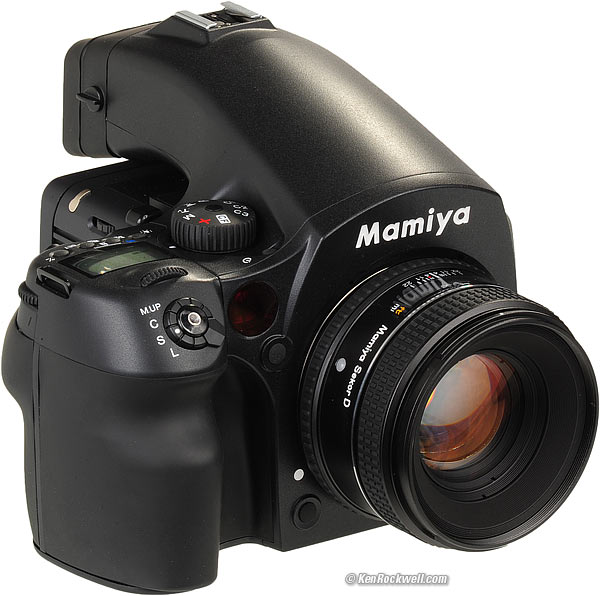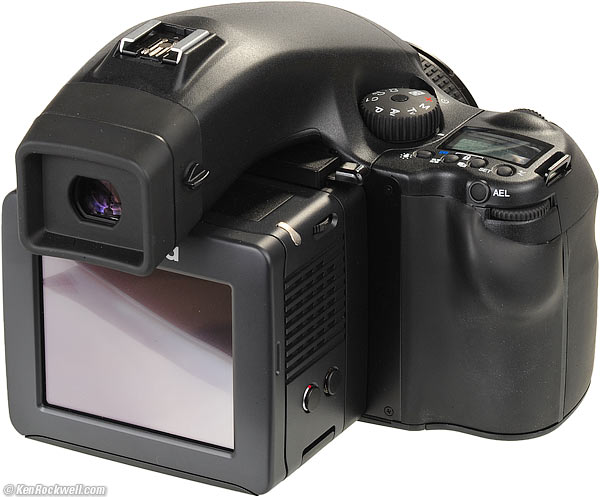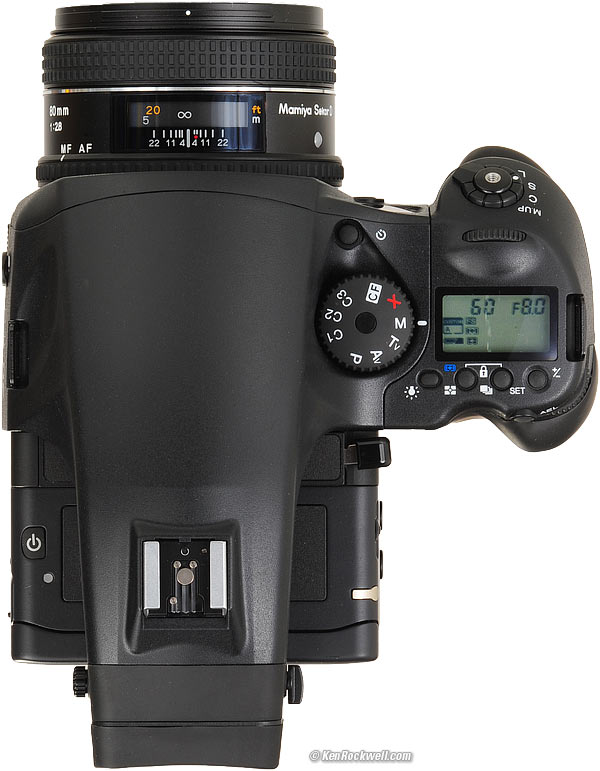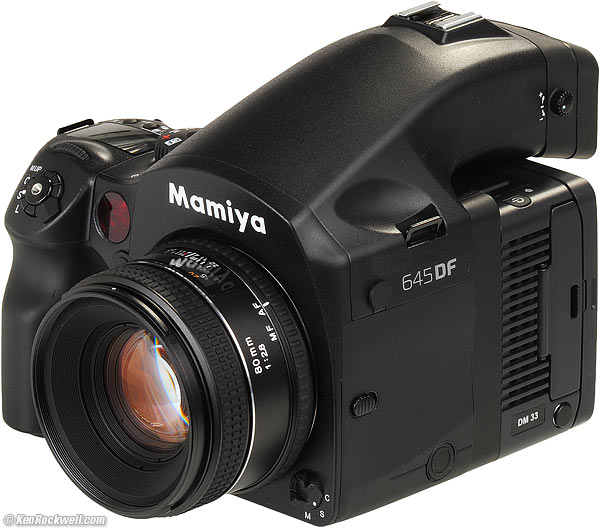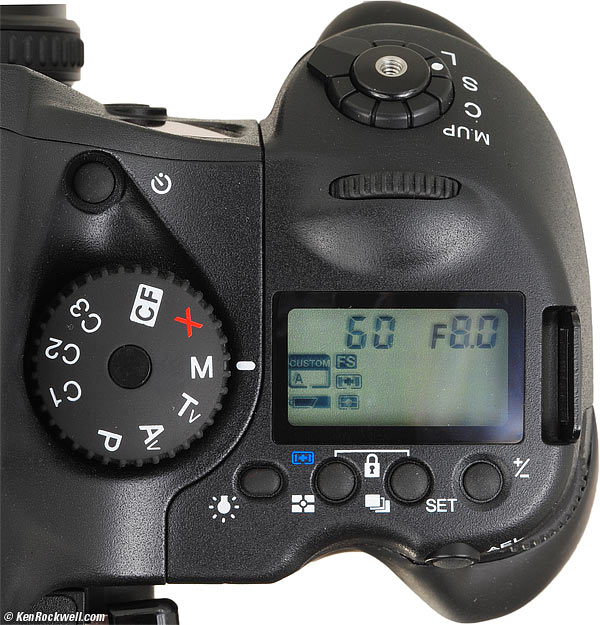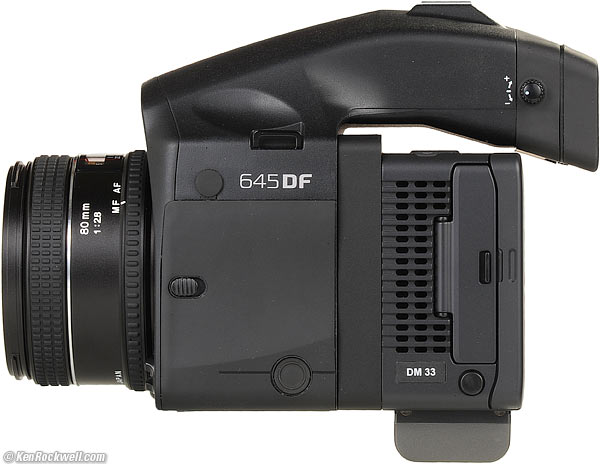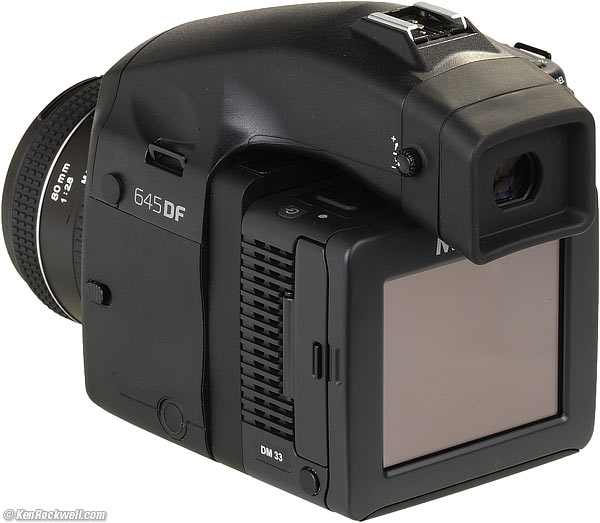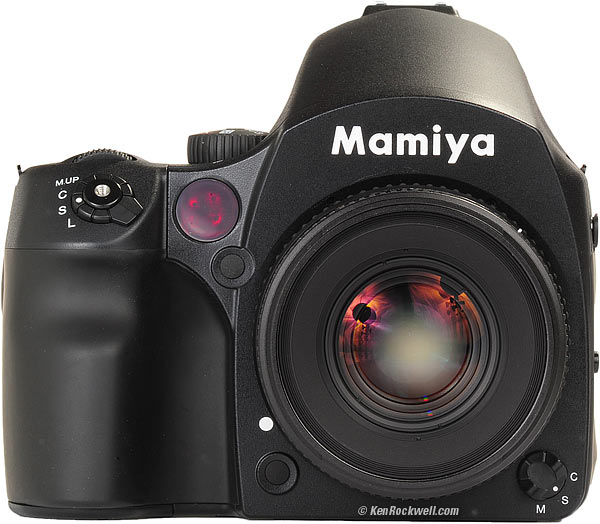Home Donate New Search Gallery How-To Books Links Workshops About Contact
Mamiya DM33
33MP, $20,000 with lens (2009-)
© 2010 KenRockwell.com. All rights reserved.
Intro Specs Performance Usage Recommendations
Mamiya DM33, 645DF and 80mm f/2.8 lens. enlarge. I'd get it at Adorama (digital back or complete camera) or my local dealer OC Camera, who loaned me this one to test. OC Camera may also be able to loan you one if you're considering a Mamiya. It helps me keep adding to this site when you use these links to get your goodies. Thanks! Ken.
See also: The Mamiya DM28 ($15,000 with camera and lens, or $13,000 for the back alone) and Mamiya DM22 ($10,000 for the camera and lens, or $8,000 for the back alone) are the same thing, with less pixels and with the 645AFDIII body instead, which also works in RealRaw.
This DM33, and the DM40 and DM 56 use the 645DF body, which allows the use of leaf-shutter lenses for fast sync, while the DM22 and DM28 use the older 645AF III body which can't use the leaf-shutters, but will take film backs.
March 2010 More Mamiya Reviews
Sharpness Comparison among the Mamiya DM33, LEICA M9, Canon 5D Mark II and Nikon D3
High ISO Comparison among the Mamiya DM33, LEICA M9, Canon 5D Mark II, Nikon D3 and Canon S90
Crummy Mamiya DM33 Sample Image (limited depth of field).
Great for: Ultimate digital capture quality in the studio, or if you don't mind hauling it around in the field.
Not for: Sports or casual use. This is a big, expensive rig that demands professional skills. The DM33 has great capabilities, but if your photography isn't already at the highest level, you're not going to get any better pictures out of this Mamiya DM33 than you will out of a Canon S90.
Introduction top
Intro Specs Performance Usage Recommendations
|
I personally buy from Adorama, Amazon, Ritz, B&H, Calumet and J&R. I can't vouch for ads below.
|
I am very impressed with the Mamiya DM33. After reviewing just about every 35mm DSLR there is, I didn't expect anything much different.
I was in for a pleasant surprise. Just as medium format film has always been wildly superior to 35mm film, the Mamiya DM33 is far superior technically to even the very best 35mm-based digital cameras.
Yes, it has more resolution, but it also has far better differentiation between subtle differences in tone, and even better than the Mamiya salesmen claimed, works at least as well as 35mm-based DSLRs at high ISOs.
This is a very serious professional camera. To get the most out of it, you need to be using your current cameras to their limits, which very, very few people do. If bought by a rich, but casual amateur, the pictures out of a DM33 aren't going to be any more compelling that whatever else one might use for shooting.
If you know what you're doing and don't mind packing a little more with you, the results are technically beyond anything from LEICA, Nikon or Canon.
The DM33 has nothing in common with consumer products like the Canon 1Ds Mark III or the Nikon D3X.
If you're considering buying one of these Mamiya's, be sure to borrow or rent one to be sure it's to your liking. If you've shot Hasselblad or Contax 645, it's about the same size and feel.
The images are technically better, but everything runs just a little bit more slowly than Canons and Nikons, which are designed for news and sports more than they are designed for studio or fine art work.
Price top
The Mamiya DM33 comes either as a complete camera, as shown with 80mm f/2.8 lens for $20,000, or as the digital back alone, for $18,000.
I am reviewing the complete camera system.
The Mamiya DM33 is a big professional camera intended for studio and very serious field professionals.
The 645DF body has no RealRaw capability. For that, you need an older model 645AF body.
Who is Mamiya? top
Mamiya has been making medium format cameras for over 50 years.
Most super-pros like Annie Leibovitz have shot with them.
I've been shooting with the Mamiya 6 since the early 1990s, and the newer Mamiya 7 for 15 years.
Mamiya never had the name recognition with laypeople that Hasselblad has, but as far as I know, I know more pros that shoot with Mamiya than do with Hasselblad.
As one of my friends, who is regularly published in Arizona Highways, would point out when she'd interview for a job, and a layperson would childishly ask "do you have a Hasselblad," she'd reply: "No, I have a Mamiya 6x7, which is even better."
Pros have been using Mamiya for decades because it costs less and gives the same results. When you're a pro, you're in it to make money, not to spend it.
Personally, I think that the Mamiya 6 and Mamiya 7 are the best cameras ever made.
Construction quality has never been as good as Canon, Nikon or LEICA, but image quality from the larger format has always been better.
Today, Mamiya has successfully made the jump to digital that killed brands like Contax, and Mamiya still stands out as the value leader as it always has in medium format.
Mamiya used to pitch themselves as "The Master of the Medium," since they've made medium-format cameras in more shapes and sizes than Rollei, Contax or Hasselblad ever have.
Rear, Mamiya DM33, 645DF and 80mm f/2.8 lens. enlarge.
Top, Mamiya DM33, 645DF and 80mm f/2.8 lens. enlarge.
DM33 with battery pack. bigger.
Specifications top
Intro Specs Performance Usage Recommendations
Sensor Size
36 x 48mm sensor (60mm diagonal)
6,726 x 5,040 pixels, including the ones painted black at the edges that never make any part of the image.
Crop Factor
1.16x compared to 645 film (41.5 x 56mm).
0.72x compared to 35mm film.
ISO
ISO 50, 100, 200, 400 and 800.
No auto ISO.
Image Size
33-1/3 megapixels
Depending on your software, about 6,666 x 4,992 (Phase One Capture One) to 6x658 x 4,984 pixels (Photoshop CS2 ACR).
File Format
.MOS raw data.
If, and only if you record them as uncompressed, they can be read in Photoshop CS3 and CS4.
If you use either of the compressed options, the files can only be read in Phase One Capture One or possibly other professional non-Adobe software.
File Sizes (as recorded to the card)
64MB, uncompressed.
30 - 45MB, losslessly compressed.
Shutter
1/4,000 to 30 seconds.
No bulb; the longest time is 30 seconds, period.
Remote Release
Standard threaded cable release, whoo hoo!
Flash Sync
1/125,focal plane shutter.
Some leaf shutter lenses sync at up to 1/800.
Future leaf-shutter lenses might sync at up to 1/1,600.
LCD
Touch screen.
3.3," smaller than the 6x7cm specified.
Storage
One CF card, or
tethered to a computer via Firewire 800.
Power
Camera body: 6 AA.
Digital back: dedicated Li-Ion, or powered directly from the FireWire 800 cord.
Weight
If you have to ask, shoot a LEICA.
80/2.8 Lens
67mm filters.
6 elements in 5 groups.
2 feet (0.6m) close-focus
Primitive 6-bladed diaphragm, stopping down to f/22.
Mechanical (screwdriver) autofocus.
Mamiya DM33, 645DF and 80mm f/2.8 lens. enlarge.
Performance top
Intro Specs Performance Usage Recommendations
I'm impressed: the technical image quality is better than I expected, and so is the ease-of use.
I'm unimpressed with the ergonomics of the camera body, while everything about the digital back and the files it makes is great.
Let's start off with my whining about the 645DF camera body, and then get on to the good stuff.
645DF Camera Body top
FInder
The finder is beautiful.
The focus screen is super bright and contrasty.
The digital readouts are also great, just like Nikon and much better than Canon.
Autofocus top
AF is fast enough, but the super-high resolution of the back is usually revealing enough to show that the 645DF doesn't always nail perfect focus if you're looking closely at larger apertures. What looks great on the ground glass and great on film may not be close enough on digital if you're using a microscope.
People who shoot these don't shoot them at f/2.8, so it shouldn't be a big deal. If it is for you, be sure to borrow one first.
The AF system is primitive, handling like something out of Nikon in the 1980s.
You have to move a ring to swap between auto and manual focus, as you also do on the Pentax 645N. The Mamiya focuses with a mechanical screwdriver coupling between camera and lens.
The Contax 645's electronic AF is far superior, allowing instant manual focus override simply by grabbing the focus ring. Canon and Nikon do this too, today, but not this Mamiya.
Flash top
I don't think I blew anything up by slamming Nikon-dedicated flashes into the hot shoe.
I used an SB-30 as a trigger for my studio strobes, and I shot with an SB-20 in Auto mode as an on-camera light source, both of which worked fine. No, I had no finder symbols, but the flashes fired and everything seems OK.
I have no idea what flashes you're supposed to use with this Mamiya.
Controls and Ergonomics top
Mamiya 645DF Controls. bigger.
I dislike the 645DF base camera body. It is as bad ergonomically as SLRs get.
The 645DF is poorly designed, with menus, CFNs and needless buttons instead of real control dials as befits a professional camera.
I far prefer the Contax 645, which is designed so well that it needs no custom functions or memory banks, and needs no external LCDs. The Contax 645 just shoots, with dedicated knobs for everything, like bracketing, apertures, shooting modes, exposure compensation, shutter speeds, mirror lockups, and well, everything. The Contax 645 just goes.
Even the Pentax 645N has far superior ergonomics to the Mamiya 645DF, also with dedicated knobs for everything.
By comparison, when I asked what the LCD was trying to tell me when it said something meaningless like "crdf 01" on the Mamiya 645DF, neither of the Mamiya tech or sales reps showing me the camera had any idea.
When I asked how to program the custom functions, none of the four of us standing there had any idea, and two of them were Mamiya employees. The CFNs come up as numeric codes, like on a Nikon F100 from the 1990s. This means that you need to carry a reference card, or forget it.
What do you do with the C1, C2, C3 and [CF] positions on the dial? I hope you have your manual with you.
It's a pain to set exposure compensation. See the button on top? You can't hit it while the camera is to your eye! Once you do contort yourself to hit it, the finder indication is excellent, but the top LCD uses tiny, almost invisible numbers while trying to set it. This is not professional.
The AEL button is in a decent place.
The two control dials are reversed. The front dial sets shutter speed, and the rear dial controls the lens. A real camera would have a shutter dial and an aperture ring, as does the Contax 645 and the Pentax 645N.
The shutter button and power switch is flimsy. It's cheap and feels like a toy. At least it's threaded for a real cable release.
Instead of the LCD illuminator being where you can find it in the dark, like around the power switch on Nikon, it's an invisible button on the top panel.
If you can get over the outdated 1990s ergonomics, there are some nice electronic features in the 645DF.
When you use AEL, brackets appear around the locked exposure values, and then the exposure offset between your locked value and the metered value shows numerically to the right of the metered values. For instance, if you hit AEL as you meter a backlit face closely at f/8 and 1/125, hit AEL and you'll now see [ 8 125]. Step back to shoot against backlight, and you'll still see [ 8 125 ], and you'll see +1.7 appear next to it ( [ 8 125 ] +1.7) letting you know the image is going to be high-key. Clever!
In manual exposure mode, you also see this offset in the finder.
Build Quality top
Mamiya has never been a camera for collectors. It's probably the poorest-built big-name camera sold in the USA.
Both my Mamiya 6 and Mamiya 7 have had parts fall off them, but I love them just the same due to their superior ergonomics.
I don't love the Mamiya 645DF's ergonomics.
Power top
Bottom, Mamiya DM33, 645DF and 80mm f/2.8 lens. enlarge.
The 645DF body takes 6 AA cells in the grip.
The Mamiya DM33 back takes its own dedicated Li-Ion pack, or is powered through Firewire 800. As shown here, the pack is removed to give access to the Firewire port for power.
80mm f/2.8 Lens top
The included 80mm lens is marvelous. My biggest whine is the simple 6-bladed diaphragm; the optics are great.
Distortion
Any distortion is invisible.
For critical use, use a value of +0.5 in Photoshop's Lens Distortion Filter at 3 meters (ten feet).
Sharpness
Better than expected, it's super-sharp, even at f/2.8 in the corners.
It's a tiny bit less contrasty in the corners at f/2.8, but I can only see this with dedicated tests. By f/4, everything is perfect, and even at f/2.8 it is fantastic.
The biggest barrier to sharpness isn't the lens, it's the accuracy of the camera's AF system.
DM33 Digital Back top
The digital back is very nice. It even has a small cooling fan that runs most of the time.
Ergonomics
To my pleasant surprise, it handles much faster then 35mm DSLRs. Why? Because it's not loaded with 3,684 idiotic menu items thrown in to impress the impressionable.
The DM33 has a touch screen, and it works better than any other touch screen short of an iPod or iPhone.
It is easy to hit just about anything I need to adjust in a click or two, without the retarded clicking away on four navigation arrows and MENU and OK buttons I'd have to do with every other camera.
The DM33 has no, and needs no menu, SET, OK, or up down left right buttons. Instead of jacking off your camera as you do with Canon and Nikon, you click what you need directly on the screen, and you're done.
My biggest whine is that most settings ignore you unless you tap the "OK" option at the end. This means that whenever I tried to change the ISO that it ignored me. This is a good feature because the person who shoots a camera like this usually doesn't want his settings changed. It's only an annoyance when you first get the camera and are playing with it.
Processing time top
Again to my very pleasant surprise, the DM33 is far faster and smoother than the LEICA M9.
If you don't need more than about 1 FPS, which the people who shoot these cameras don't, it handles as fast as any top 35mm DSLR, which is worlds better than trying to shoot a LEICA M9 quickly. (We're hoping LEICA fixes the bugs in the M9's firmware.)
The LEICA M9 takes about 40 seconds to process and write 7 shots from its buffer to the card, during which time you're dead in the water if you've filled the buffer. The LEICA M9 takes several seconds to process and write each and every shot. It's easy to bonk the M9's buffer and have to wait.
By comparison, the DM33 clears each shot in only about a second. No, you can't shoot any faster then 1 FPS, but you can keep shooting a frame every second or so forever. By comparison, the LEICA M9 gets stuck after just a few frames of rapid shooting since it can't clear its buffer faster than about one frame every four seconds. (The M9's problem is slow internal processing, not writing data to the card.)
I had about the same lost data rate from the Mamiya DM33 as from the LEICA M9. I can lose shots if I shoot the M9 too hard and fill its buffer. In 100 shots, I once got a BEEP and a red warning on the DM33's LCD that it lost the shot I just made. OOPS! That's worlds better than the LEICA, since the LEICA M9 hangs up and loses shots without telling me if I'm shooting indiscriminately.
Canon and Nikon haven't had these file-bung issues for the past ten years, however Canon and Nikon have sloppy and careless menu systems so bloated with garbage and so poorly thought out that no one can figure them out. The Mamiya and LEICA menu systems are trivial to navigate because someone actually took the time to put them in order. This makes a huge difference when out shooting.
After shooting the LEICA M9, shooting the DM33 is much faster and smother, since I never have to wait for the digital side to catch up.
Another nice feature is that while the DM33 is taking just a second to get everything in order for the next shot, its finder LCD displays how many shots you've got left.
Data top
CF cards may be hot-swapped, so don't worry.
There is none of the amateur DCIM file folder nonsense.
You can select where the files are recorded, and by default, they drop right into the root director of your card.
Thus when you call up your CF card, your files are right there without having to click on subfolders, yay.
Power top
Mamiya DM33 with battery pack. enlarge.
The battery pokes out of the bottom. It's not like the PR photos.
The really neat part is that you remove the battery to get to the Firewire 800 socket. The back is magically powered through the firewire cable when shooting tethered, so no battery required. It will run off the battery in your MacBook or PowerMac.
The battery charge is always visible on the rear LCD while shooting.
I didn't shoot that much, and never ran down a battery. I'm impressed; it even powers a small fan in the back.
The camera body takes an additional 6 AA cells in the grip.
LCD top
Rear, Mamiya DM33, 645DF and 80mm f/2.8 lens. enlarge.
The LCD touch screen is great for camera control.
You see no buttons on the back because the Mamiya DM33 doesn't need any: it's all in the touch screen.
The touch-screen interface is worlds better than the garbage menu navigation buttons from Canon, Nikon or LEICA.
The DM33's screen is more responsive than any other touch screen short of the superior iPhone or iPod Touch.
Sadly, the LCD is crummy for image evaluation. It is low-resolution, low-contrast (due to the touch-screen) and low-color-accuracy. It looks grainy and colors are poor.
Any Nikon or iPod Touch has a far better, sharper and more color-accurate screen. Let's be serious: you don't use the 3.3" LCD for critical analysis of images on a $20,000 camera.
Images on the DM33's LCD are dull and grainy: you can see each of the LCD's pixels.
The LCD playback image rotates as you rotate the camera. Even better, the data displayed on the LCD also rotates along with the image, yay!
The histogram is very smart: it shows its estimate of exposure error in fractions of stops, color-coded for how far off!
Thus I love the LCD. It makes the camera work very, very well. Too bad only Apple knows how to make a great-looking touch screen.
I have little idea why the Mamiya DM33 comes with a clear cover for the LCD. You can't control anything with the cover attached.
Image Quality top
I've already shown resolution comparisons, tonality comparisons and high-ISO comparisons. The Mamiya DM33 easily outperforms anything in 35mm digital.
None of that has much to do with image quality. Technical image quality is all about value and color.
Since the Mamiya DM33 can't make any real images and only spits out raw data, the look of your images is entirely dependant on the software used to process the files, and more so, who's operating that software.
It is rare to see aliasing, but I have seen it. It will vary with your choice of software.
People who buy these cameras have people called Digital Techs working for them. The photographer shoots, and the Digital Tech handles all the computer BS, software, profiling and etc., so the photographer can concentrate on the photography.
The Tech is responsible to be sure that the photographer gets the look he needs.
Marketing claims like "12 stop dynamic range!" are baloney. Pros know that great highlights and shadows come from lighting the set properly, not trying to rescue it in software later.
The people who buy these spend hours lighting a set, and hours (or days) setting up what they are going to shoot.
I can't tell you if you're going to love the DM33 or not. You need to borrow or rent one and see if you and your Digital Tech can get the look you want out of it.
From my use, colors seem similar to Nikon and Canon raw files when opened in the same software. The LEICA M9 is always the odd man out, with usually weird colors by comparison.
The people who shoot the Mamiya digital love it.
I didn't have the time to try any serious photography with it, and if I did, I have no Digital Tech to try to twiddle software for me to get the look I want.
This Mamiya DM33 Sample Image I shot by flipping the tables and making a shot of my usual studio rig. This shot was processed through Phase One Capture One software v 5.1, shot at ISO 50 and f/16 under studio strobes with the 80mm lens at its close focus distance of about two feet (0.6m). Note that field is limited, everything is not in focus.
Usage top
Intro Specs Performance Usage Recommendations
There are TWO sets of batteries and TWO power switches: one on the camera body, and another on the DM33 digital back.
The power LED on the DM33 back is usually green; it turns yellow if there is no card.
The menu system is incorrectly named:
The first CAMERA menu is really the shooting menu with ISOs and likewise.
If you change camera settings, be sure to hit OK, otherwise the DM33 ignores your changes.
The SHOOT menu is really for playback.
The MOS files are only compatible with Adobe software if you shoot 64MB uncompressed files. The more efficient compressed files only open with dedicated professional software, like Phase One Capture One.
Mamiya DM33, 645DF and 80mm f/2.8 lens. enlarge.
Recommendations top
Intro Specs Performance Usage Recommendations
If you want the highest possible digital capture quality, the Mamiya DM33 is definitely worth a look as a significant step up from LEICA, Canon and Nikon.
If you buy one of these, be sure to borrow or rent one to be sure you like it and what it does. I think it works great, but don't go spending $20k without a test drive.
Unlike Canon and Nikon which are so common that we all know what they do, professional gear like this is completely different.
It can't improve your photography. If you're not happy with the results you're getting from your camera today, you won't be any more happy with the DM33. To get great results out of the DM33, you need to be an accomplished photographer, jut as you need to be to get great results out of any camera.
Am I getting one? No way. I prefer film. I much prefer the results I get on Velvia from my Mamiya 6 and Mamiya 7 over anything that comes from digital, and they are smaller, lighter, and easier to shoot, support and pack in the field.
The Mamiya DM33 is for use by commercial photographers who need the highest quality files immediately. It's for people who can't afford to wait a few hours for their film to come back. If you're an artist working in the field, you don't need your files in 60 seconds; you can use large-format film for better results since you're in no rush.
If you're more concerned about the image than the time period, then the premium price paid here for the best in digital capture isn't that relevant. Stick with film.
The DM33 is completely different from film. If you like what you get from film, stick with it. If you need digital files, then by all means consider the DM33.
If all you know is digital, and if you don't mind the size and weight, you'll love the DM33 for use in the field over 35mm-based digital cameras so long as your subjects hold reasonably still. I was quite pleasantly surprised shooting the DM33.
Do know that you're obligating someone to a lot of computer time with the DM33. Pros have Digital Techs to do this computer foolishness for them; if you don't have people working for you, know that it will take a lot of computer time to process all the MOS files into something you can preview and from which you can start selecting, and more time to process into final images.
Unlike consumer cameras, there are no JPGs, and the MOS raw files are huge.
If $20,000 is a big deal for you, then stick with the Canon 5D Mark II for nature and landscape digital capture. If you need the best in digital capture, check out medium format. The people who spend $20,000 on these are pros who used to have $10,000 a month film and lab bills, so it pays for itself.
See also Is It Worth It.
More Information
Mamiya USA's page on the DM33.
Phase One (Capture One software).
Help me help you top
I support my growing family through this website, as crazy as it might seem.
If you find this as helpful as a book you might have had to buy or a workshop you may have had to take, feel free to help me continue helping everyone.
If you've gotten your gear through one of my links or helped otherwise, you're family. It's great people like you who allow me to keep adding to this site full-time. Thanks!
If you haven't helped yet, please do, and consider helping me with a gift of $5.00.
The biggest help is when you use any of these links when you get anything. It costs you nothing, and is this site's, and thus my family's, biggest source of support. These places always have the best prices and service, which is why I've used them since before this website existed. I recommend them all personally.
Thanks for reading!
Ken
Home Donate New Search Gallery How-To Books Links Workshops About Contact

